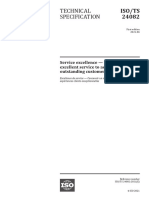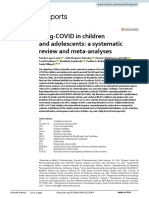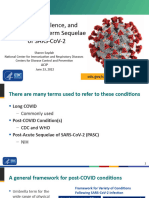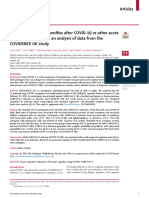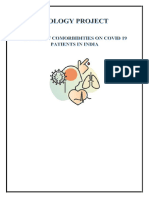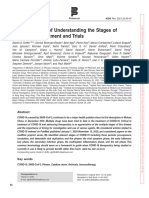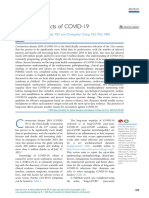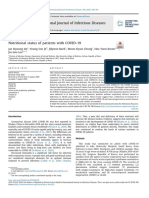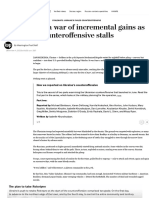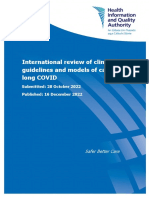Trisha Greenhalgh-Management Long Covid-Update For Primary Care-09 - 2022-s Coment
Trisha Greenhalgh-Management Long Covid-Update For Primary Care-09 - 2022-s Coment
Uploaded by
Zezinho zéCopyright:
Available Formats
Trisha Greenhalgh-Management Long Covid-Update For Primary Care-09 - 2022-s Coment
Trisha Greenhalgh-Management Long Covid-Update For Primary Care-09 - 2022-s Coment
Uploaded by
Zezinho zéOriginal Title
Copyright
Available Formats
Share this document
Did you find this document useful?
Is this content inappropriate?
Copyright:
Available Formats
Trisha Greenhalgh-Management Long Covid-Update For Primary Care-09 - 2022-s Coment
Trisha Greenhalgh-Management Long Covid-Update For Primary Care-09 - 2022-s Coment
Uploaded by
Zezinho zéCopyright:
Available Formats
https://www.bmj.
com/content/378/bmj-2022-072117
PRACTICE
Referência: Greenhalgh T, Sivan M, Delaney B, Evans R, Milne R. Long covid—an
BMJ: first published as 10.1136/bmj-2022-072117 on 22 September 2022. Downloaded from http://www.bmj.com/ on 15 November 2022 by guest. Protected by copyright.
update for primary care BMJ 2022; 378 :e072117 doi:10.1136/bmj-2022-072117
1 Nuffield Department of Primary Care PRACTICE POINTER
Health Sciences, University of Oxford,
Oxford, UK
2 Leeds Institute of Rheumatic and
Long covid—an update for primary care
Musculoskeletal Medicine, University Trisha Greenhalgh, 1 Manoj Sivan, 2 Brendan Delaney, 3 Rachael Evans, 4 Ruairidh Milne5
of Leeds, Leeds, UK
What you need to know 2000) has around 65 patients with long covid, 27 of
3 Institute of Global Health Innovation,
whom will have been unwell for more than a year,
Imperial College London, London, UK
• Long covid (prolonged symptoms following covid-19 and 12 for more than two years. Most general practices
4 Institute for Lung Health, Department infection) is common have far fewer patients with a long covid diagnostic
of Respiratory Sciences, University of • The mainstay of management is supportive, holistic code on their electronic health record9 for a
Leicester, Leicester, UK
care, symptom control, and detection of treatable combination of reasons, including lack of
5 School of Healthcare Enterprise and complications presentation, lack of recognition, and inadequate
Innovation, University of • Many patients can be supported effectively in primary coding. These figures do not cover children, who are
Southampton, Southampton, UK outside the scope of this article.
care by a GP with a special interest
Correspondence to T Greenhalgh
trish.greenhalgh@phc.ox.ac.uk Rates of long covid are lower in people who are triple
Cite this as: BMJ 2022;378:e072117
This article updates and extends a previous BMJ vaccinated, but prevalence of long covid (persistent
http://dx.doi.org/10.1136/bmj-2022-072117
Practice Pointer published in August 2020 when symptoms at 12-16 weeks after laboratory confirmed
Published: 22 September 2022 almost no peer reviewed research or evidence based SARS-CoV-2 infection) remains high at 5% for the
guidance on the condition was available.1 In this delta variant and 4.2% for omicron BA.2.10
update we outline how clinicians might respond to
the questions that patients ask. Symptoms and case definition
Long covid may be diagnosed late or not at all,11 -13
Definition
so both generalists and specialists should be alert to
The term “long covid”2 refers to prolonged symptoms it as a differential, while also being aware that
following infection with SARS-CoV-2 that are not patients can develop other persistent symptoms
explained by an alternative diagnosis. It embraces following acute covid-19 that are not necessarily
the National Institute for Health and Care Excellence caused by covid-19. Long covid is characterised by a
(NICE)’s terms “ongoing symptomatic covid-19” constellation of general and organ specific symptoms,
(symptoms lasting 4-12 weeks) and “post covid-19 the commonest of which are summarised in the
syndrome” (symptoms beyond 12 weeks),3 the US infographic. These multiple manifestations lead to
Centers for Disease Control and Prevention’s group difficulties with daily activities such as washing and
of “post-covid conditions,”4 and the World Health dressing, low exercise tolerance, and impaired ability
Organization’s “post covid-19 condition.”5 to work (either at all or partially), and result in
reduced quality of life.5 14 -19
Epidemiology
Symptoms typically occur across multiple systems
In mid-2022, approximately 70% of the UK adult
concurrently but sometimes one organ system (eg,
population had been infected with SARS-CoV-2.6 Of
cardiovascular) dominates. Phenotyping studies have
these, almost 2 million report covid-19 symptoms
identified several symptom clusters (table 1), with
persisting for more than four weeks; 807 000 (41%
severe cases characterised by greater number and
of all people with long covid) for more than a year;
intensity of symptoms and greater functional
and 403 000 (19%) for more than two years.7 Based
impairment.33 -35 Some patients’ long covid follows
on workforce data from the British Medical
a fairly constant course, while others experience
Association,8 a full time equivalent general
relapsing and remitting symptoms, sometimes with
practitioner with an average list size (approximately
particular triggers.36
the bmj | BMJ 2022;378:e072117 | doi: 10.1136/bmj-2022-072117 1
PRACTICE
BMJ: first published as 10.1136/bmj-2022-072117 on 22 September 2022. Downloaded from http://www.bmj.com/ on 15 November 2022 by guest. Protected by copyright.
Table 1 | Symptoms, investigation, and management of long covid
Symptom cluster Description and impact on daily life Investigations (in addition to full clinical Management
examination)
Fatigue, low exercise tolerance, deconditioning “Battery flat,” unable to do usual activities. Bloods as appropriate (eg, full blood count, urea Holistic management is key. Self-management
(eg, post-ICU) Trying to do more may worsen symptoms. In and electrolytes, renal, thyroid, vitamin D, C to function within available energy limits (eg,
some cases, fatigue does not improve with rest reactive protein, B12, ferritin). Exclude other prioritising, planning, building in breaks and
causes of fatigue. Monitor symptom severity rests, knowing when to stop20). Signpost to
and frequency and pattern of relapses (eg, resources (see box, Resources for patients)
using the C19-YRS outcome measure). Consider
autonomic dysfunction (see below)
Post-exertional symptom exacerbation (PESE) “Crash,” “relapse” worsening of symptoms Monitor symptom severity and frequency and Signpost to resources. Pacing in phases (see
(physical, cognitive, or emotional), or new pattern of relapses (eg, using C19-YRS). A WHO self-management booklet, box, Resources
symptoms, following exertion patient activity diary can record triggers (for for patients)
relapse)
Exertional breathlessness Short of breath predominantly with physical Guided by specific symptoms. Assess impact Refer according to clinical concern (eg,
activity on function (eg, using item 1 of C19-YRS). worsening symptoms, resting or exertional
Haemoglobin, spirometry, full lung function hypoxia, unexplained abnormal spirometry,
tests as indicated. Natriuretic peptides and abnormal chest x ray image)
echocardiogram as indicated if heart failure
suspected. Pulse oximetry and sit-to-stand test
for exertional hypoxia.21 Chest x ray image
(especially if patient was hospitalised) if
persistent lung damage suspected and to
exclude other causes.22 D dimer if acute
pulmonary embolism suspected (note that a
negative result does not exclude chronic
pulmonary emboli23)
Altered breathing/breathing pattern disorder Pressure in chest (“covid squeeze”), shallow Exclude other causes of breathlessness as Recommend breathing control exercises,
breathing, breathlessness with or without listed above, especially causes of episodic signpost to online resources for breathing
exertion, sense of needing to work harder to breathlessness such as asthma or recurrent pattern disorder (box, Resources for patients),
take a breath, or air hunger (“can’t get enough pulmonary embolism and if no improvement refer to specialist
air”)
Chest pain Pain in specific positions, pain on exertion, “lung Guided by specific symptoms. Chest pain may Chest pain with angina-like features warrants
burn,” pressure (“like an elephant sitting on indicate microvascular angina, myocardial referral to a rapid access chest pain clinic.
my chest”) infarction, myo- or pericarditis, pulmonary Consider colchicine or anti-inflammatory
embolism or costochondritis. ECG, troponin, D analgesics for inflammatory type pain once
dimer, oximetry (including sit-to-stand test), other causes excluded
vitamin D, imaging as indicated
Throat and voice symptoms “Covid strangle”—sore or dry throat with Full history and assessment to explore If not improving, refer to ear, nose, and throat
sensation of choking; altered voice differential diagnosis (eg, covid related vocal or speech and language therapist as
cord pathology, gastro-oesophageal reflux, appropriate
sinus disease, strained voice, dehydration)
Autonomic dysfunction Palpitations, dizziness, orthostatic tachycardia, NASA 10-minute lean test to check for postural Fluids, electrolytes, compression garments,
gastro-intestinal disturbance, generalised pain orthostatic tachycardia syndrome (POTS)24 lifestyle adaptation, and specialist rehabilitation
(protocol in supplementary file).25 if tolerated. Various drugs are under
Investigations for other causes of autonomic investigation.26 Specialist referral if symptoms
dysfunction/POTS if positive. 24 hour ECG and severe or diagnosis in doubt
blood pressure
Neurocognitive dysfunction “Brain fog” (poor short term memory, Brief cognitive screening test (eg, mini mental Strategies of pacing and energy conservation,
concentration, problem solving, and executive state examination27). Fatigue investigations as to-do list diary, avoid multitasking. If unable to
function). Mental fatigue above. If memory loss pre-dated covid-19 and work or have a safety critical occupation, refer
is now worsening, follow usual investigations for formal neuropsychological testing
and pathway
Dizziness and vertigo Unpleasant episodes, “room spinning,” nausea Full history to identify timing and triggers and Precautionary measures to avoid falls, head tilt
ascertain if resolving. Clinical examination (eg, and balance exercises, encouraging movement
nystagmus, other neurological signs, postural and activity focusing on environmental cues.
drop in blood pressure) Refer to audiology if indicated
Loss of smell Loss of enjoyment of food and mealtimes. Clinical examination to exclude nasal polyps, Smell training (see box, Resources for patients).
Phantosmia (a persistent, disagreeable chronic sinusitis, and rare inflammatory or Experiment with different foods and menus to
background smell) or parosmia (distorted sense neoplastic conditions of nasal cavity and cranial find palatable options. Steroid nasal spray may
of smell)28 nerves help in some cases
Allergic-type symptoms Skin rashes (eg, urticaria), conjunctivitis, Confirm urticaria clinically (eg, dermographism). Antihistamines (obtainable over the counter)
abdominal bloating, regurgitation If present, may indicate mast cell overactivity. may help. A clinical trial of specific
Resurgent atopy (eg, hay fever recurring after antihistamines is underway
many years) is common post covid (STIMULATE-ICP).29 Allergy or immunology
referral if fulfils local criteria (eg, anaphylaxis)
2 the bmj | BMJ 2022;378:e072117 | doi: 10.1136/bmj-2022-072117
PRACTICE
BMJ: first published as 10.1136/bmj-2022-072117 on 22 September 2022. Downloaded from http://www.bmj.com/ on 15 November 2022 by guest. Protected by copyright.
Table 1 | Symptoms, investigation, and management of long covid (Continued)
Symptom cluster Description and impact on daily life Investigations (in addition to full clinical Management
examination)
Poor sleep Unrefreshing sleep, exhaustion, exacerbation Assess daytime somnolence (eg, using Epworth Sleep hygiene measures (eg, structured
of fatigue and brain fog, vivid dreams or sleepiness scale30); exclude underlying causes routines, exercise as able, avoid shift work if
nightmares (eg, obstructive sleep apnoea using possible, avoid caffeine and alcohol), short
STOP-Bang questionnaire31). Assess daytime naps. Melatonin may help restore
psychological health. Covid related sleep circadian rhythms in some cases (exclude other
disorder often overlaps with autonomic causes before prescribing)32
dysfunction and mast cell disorder
Mental health Anxiety, depression, post-traumatic stress Full history (hear the patient’s story; witness Whole person care. Adjusting to illness. Talking
disorder (PTSD). Loss of identity and purpose their experience; affirm their lived experience). therapy, meditation, and medication if
Carefully distinguish anxiety from POTS (see indicated. Mental health referral or social
above). Assess risk of self-harm and risk to any prescribing if appropriate
dependents
Joint and muscle pain Generalised, focal, or regional pain. May be in Investigations guided by history and clinical Non-steroidal anti-inflammatory drugs.
“coat hanger” distribution. May progress to examination. C reactive protein (if inflammatory Mobilisation within personal limits. Consider
chronic pain disorder suspected), creatine kinase (if trial of neuropathic agents (amitriptyline,
myositis suspected). Additional tests as gabapentin, pregabalin) in chronic cases,
indicated for rheumatological disorders especially if neuropathic symptoms
Fatigue—described by one patient as “like the most severe jet lag disease.34 44 It is more common in people who were hospitalised,
and hangover I’ve ever had”37—is the commonest symptom and aged 35 to 69, female, living in deprived areas, working in
may be associated with severe functional impairment; reduced healthcare, social care, or education, with high body mass index,
exercise tolerance is also common. Some patients develop and with more than one pre-existing, activity limiting health
post-exertional malaise (PEM) or post-exertional symptom condition.7 34 44 -46
exacerbation (PESE),11 defined as worsening of symptoms following
The underlying cause of long covid is not fully known, but several
physical or mental exertion, typically 12 to 48 hours after activity
interacting mechanisms likely contribute.47 -49 A chronic, low grade
and lasting days or (rarely) weeks.38 Long covid has evident (but
inflammatory response is correlated with the severity of ongoing
under-researched) overlaps with chronic fatigue and myalgic
symptoms in patients who were hospitalised.33 Some patients have
encephalomyelitis.39Box 1 gives examples of patients’ accounts.
evidence of multi-organ microvascular disease characterised by
Box 1: Patients’ accounts of long covid symptoms and accessing services, immunothrombosis and endothelial dysfunction,47 48 and some
show an autoimmune response, where the body starts to recognise
from research interviews with people with long covid13 40 41
its own tissues and organs as foreign.50 Some patients have covid
“I had an odd rash for quite a while; it kept coming and going … very itchy induced neurological damage, particularly to the autonomic nervous
cough ... very mild asthma … I started getting the odd headache again system, which controls involuntary functions like heart rate.35 46 51
.... Pins and needles, feet going completely numb ... all sorts of odd
Being chronically ill and with unpredictable relapses may lead to
symptoms, I just kept putting it down to grief until a couple of months
in, a friend said, ‘Look, do you think this could be covid?’”
loss of work, income, and social interaction, which in turn can lead
to poor mental health.14 Structural inequalities such as poverty,
“The fatigue is literally like hitting a wall. I can’t stay awake any more.
It’s just like, wow, I have to go to bed.” overcrowding, poor working conditions, and inability to access
services are important in the development and course of covid-19
“I’d had 11 days of feeling great. And after [a particular] weekend I crashed
again. And again it seemed to last for weeks of having these waves of and may form an important context for long covid.52 -54
symptoms: shortness of breath, diarrhoea, muscle aches, complete What can my primary care team do for me?
fatigue.”
“I think it [consultation with general practitioner] was a really positive Patients with long covid greatly value input from their primary care
experience and I felt really listened to, and she was able to be honest at clinician. Notwithstanding prevailing uncertainties and the lack of
that point and said I don’t really know what I can do to help you but you definitive curative therapies, generalist clinicians can help patients
can phone me or email me at any point.” considerably by
“My last interaction with my GP was in June. I asked about my lungs, and
he said, ‘What do you want me to do about it? You tell me. I have no idea.’ • Hearing the patient’s story and validating their experience
It felt very dismissive […]. ‘Nothing’s got any evidence so, yeah sorry, I
• Making the diagnosis of long covid (which does not have to be
can’t help.’ I went back to work after five weeks still very unwell because
nobody believed in long covid in May, they just didn’t believe it.” by exclusion) and excluding alternative diagnoses
• Providing holistic, relationship based care through continuity
Questions patients ask of care with a sympathetic clinician who knows the patient
Why did I get long covid, and what caused it? • Conducting a full examination in a face-to-face appointment
Symptoms (especially fatigue) may persist after many infectious • Encouraging self-management and directing to resources (box,
illnesses, including other coronaviruses such as SARS and MERS.42 Resources for patients)
But no clear explanation exists for why a particular individual
• Managing specific symptoms (table 1)
develops long covid while another recovers quickly.
• Detecting and actioning “red flag” symptoms (infographic)
Long covid is more common in those who had more severe acute
disease43 but may occur after mild or even asymptomatic
the bmj | BMJ 2022;378:e072117 | doi: 10.1136/bmj-2022-072117 3
PRACTICE
BMJ: first published as 10.1136/bmj-2022-072117 on 22 September 2022. Downloaded from http://www.bmj.com/ on 15 November 2022 by guest. Protected by copyright.
• Managing comorbidities (especially diabetes and cardiovascular disability and overall health state, known as the Covid-19 Yorkshire
disease and risk factors) Rehabilitation Scale (C19YRS), has been developed and validated
(see multimedia appendix).60 61 This instrument, which is less
• Sharing the uncertainties of prognosis
burdensome for patient and clinician than multiple condition
• Helping set realistic goals for recovery (including pacing to avoid specific scales, is available in document format (see bmj.com) and
PESE) as a smartphone app for the patient linked to a web portal for the
Considering referral to other members of the primary care team clinician (https://c19-yrs.com/).60 It can be completed at intervals
• over time to chart the patient’s recovery (or lack of it).
(eg, pharmacist, advanced clinical practitioner, community
physiotherapist) or social support services as appropriate When will I get better?
• Monitoring progress The time course of recovery is extremely variable. Approximately
Assessing mental wellbeing and managing depression and two thirds of patients who have persisting symptoms at four weeks
• can expect to be recovered by 12 weeks.43 Those still unwell at 12
anxiety as needed
weeks may benefit from specialist multidisciplinary care. They may
• Providing sickness certification still improve, albeit at a slower rate, but many patients appear to
Supporting self-advocacy (eg, with employer when returning to plateau and their illness course may fluctuate with exacerbations
• triggered by physical or mental stress.7 33 62 It is currently not
work)
possible to predict which patients will recover within weeks and
• Entering the correct code for long covid on the electronic patient which will develop a long term condition.
record.55
Do I need to see a specialist?
All this takes time, and several consultations may be needed. Many people with long covid can be managed effectively in primary
What investigations should I have? care, but “red flag” symptoms (infographic) require urgent referral
and action. Additionally, some patients—those with multiple severe
Long covid affects patients in different ways and to different degrees.
symptoms (especially if both physical and mental health are
Because a key component of care is investigating and managing
affected), symptoms persisting after a severe acute illness (eg, a
risk factors and comorbidities, no standard protocol exists for
period in intensive care), atypical symptoms, profound functional
assessment. Ideally, every patient should have an in-person
impairment (eg, unable to work or attend college), and those
consultation including a full history, clinical examination, and
needing confirmation that self-management or supported
review of comorbidities and social circumstances.
rehabilitation is safe and appropriate—benefit from specialist
Initial investigations are guided by the predominant symptoms referral.63 Ideally, this should occur in a dedicated “single point of
(table 1) and are primarily directed at excluding serious alternative entry” long covid clinic. These integrated clinics spanning primary
diagnoses. Patients may have heard about tests for immunological and secondary care give patients access to additional investigations
and clotting function; such tests are the subject of intense research and other specialists (typically including respiratory medicine,
currently, but they do not yet have an established role in clinical cardiology, neurology, rehabilitation medicine, therapists, and
practice. psychologists). Not all localities have such services, and in their
absence, a thorough history and clinical assessment should enable
What treatments are available?
a referral to be made to the most appropriate secondary care service.
As with investigations, no standard protocol exists for treating long Table 1 and the infographic provide some indicators.
covid. Recovery programmes have been designed and implemented
Because health services in many areas are currently very stretched,
with the aim of improving physical health and mental wellbeing.56
some patients may experience considerable delays even when their
The optimal content, delivery method, and duration of these
referral meets local criteria. Supportive care and symptom control
programmes is currently unknown, but under investigation (see
from the primary care team may be helpful in the interim.
EPPIcentre resource, box, Resources for healthcare professionals).
Programmes to date have been modelled on successful examples What if I’m not getting better?
such as pulmonary and cardiac rehabilitation, but with substantial
Early research on management of post-acute covid-19 assumed
modification for adults with long covid who are particularly
(explicitly or implicitly) that patients would recover, albeit slowly.
managing fatigue and PESE.57
Long covid specialist services in the UK were designed around this
Much current medication is directed at symptom control assumption and focused on assessment, rehabilitation, occupational
(paracetamol or non-steroidal anti-inflammatory drugs for fever therapy, and psychological support. Thirty months into the
and pains, antihistamines for allergic symptoms). Table 1 lists other pandemic, it is clear that this approach helps many but not all
specific medications for different symptom clusters. Covid vaccines patients, and that for a substantial minority, “recovery” currently
may help long covid symptoms and should be discussed with all means developing the ability to manage limited energy, continuing
those without contraindications who are not already fully pain, cognitive limitations, and ongoing flare ups in what has
vaccinated; they should be told that improvement may be modest become a long term condition.36 In addition to research to
and not all patients benefit (indeed, some may experience worsening characterise persisting forms of long covid and test targeted
of symptoms).33 58 59 therapies, models of integrated ongoing care more akin to those for
other long term conditions such as diabetes, heart failure, or chronic
How will I know if I’m getting better?
pain are needed, including evaluating and costing the contribution
The best guide to whether a patient is getting better is whether they of primary care to any such service. Community based
feel better (and if they do, whether this reflects permanent recovery interdisciplinary services and adequate support and training for
or temporary remission). A patient reported outcome measure that healthcare professionals are needed to rapidly improve care and
measures symptom severity across 10 domains as well as functional services for the growing numbers of people living with long covid.
4 the bmj | BMJ 2022;378:e072117 | doi: 10.1136/bmj-2022-072117
PRACTICE
BMJ: first published as 10.1136/bmj-2022-072117 on 22 September 2022. Downloaded from http://www.bmj.com/ on 15 November 2022 by guest. Protected by copyright.
Resources for patients • Health Education England long covid e-learning modules for health
Books professionals. https://www.e-lfh.org.uk/programmes/long-covid/
• The Long Covid Self Help Guide37—written by specialists at a long Online resources
covid clinic offering lay explanations and self-management strategies • Living maps of covid-19 evidence, created by the UCL EPPI-centre,
for the different symptom clusters of long covid with long covid segment. http://eppi.ioe.ac.uk/cms/Projects/Depart-
• Support for rehabilitation: self-management after COVID-19 related mentofHealthandSocialCare/Publishedreviews/COVID-19Livingsys-
tematicmapoftheevidence/tabid/3765/Default.aspx
illness—a World Health Organization guide for patients20
• Living systematic review of long covid, which will be updated as new
• Long Covid Rehabilitation Booklet from NHS Hertfordshire.
evidence emerges64
https://www.hct.nhs.uk/media/4529/long-covid-rehabilitation-
booklet-july-2021.pdf. • Long covid physio: a resource site intended mainly for
Websites physiotherapists and their patients, set up by physiotherapists who
have (had) long covid. https://longcovid.physio
• Your Covid Recovery (https://www.yourcovidrecovery.nhs.uk/)—an
NHS England funded website with public facing resources (Phase I
resources). These offer helpful advice for specific symptoms, eg, How patients were involved in the creation of this article
dizziness (https://www.yourcovidrecovery.nhs.uk/covid-in-the-last-
Patients who were members of the LOCOMOTION quality improvement
4-weeks/effects-on-your-body/dizziness/). Phase II Your Covid
Recovery is a web based covid-19 rehabilitation programme with collaborative (see protocol paper for details65) contributed the comments
healthcare professional support for those referred into the scheme in box 1. RM has lived experience of long covid and co-chairs the patient
(usually by a rehabilitation professional) advisory group for LOCOMOTION. The paper was read by three additional
patients with long covid and modified in response to their feedback.
• Physiotherapy for Breathing Pattern Disorders (https://www.physio-
We considered patient led and professionally led research on their merits,
therapyforbpd.org.uk)—a patient facing site designed and run by
aware that many high quality studies on this condition were
specialist physiotherapists
conceptualised and undertaken by patient communities (who included
• Long Covid Work (https://longcovidwork.co.uk/)—a site for people scientists, social scientists and clinicians, who brought relevant research
returning to work after long covid. skills as well as lived experience of long covid).
Support groups
• Long Covid SOS (https://www.longcovidsos.org) and Long Covid How this article was created
Support (https://www.longcovid.org). Examples of resource and
This paper draws on three sources. The first was a literature search of
networking sites set up by and for people with long covid.
PubMed using the terms “post-acute covid-19 syndrome (MeSH)”, and
“long covid (title and abstract)” and including basic science studies and
Resources for healthcare professionals reviews,11 47 48 50 narrative reviews, and conceptual papers considering
Guidelines mechanisms,14 24 26 36 45 49 52 64 66 clinical trials (of which none had
reported at the time of writing), observational studies and reviews of
• Covid-19 rapid guideline: managing the long term effects of covid-19
these,15 -17 33 34 43 44 46 62 67 -70 systematic reviews of rehabilitation
(by NICE, Royal College of GPs, and Scottish Intercollegiate Guidelines
programmes,71 studies on outcome measures,35 60 61 72 -74 social science
Network)3 studies of long covid in vulnerable groups and underserved
• Faculty of Occupational Medicine guidance for health professional communities,52 -54 surveys12 18 75 and a Delphi study76 of patient
on return to work for patients with post-covid syndrome. priorities, and qualitative studies of the patient experience.2 13 40 41 77
https://www.fom.ac.uk/wp-content/uploads/FOM-Guidance-post- Secondly, the paper drew on group discussions with front line clinicians
COVID_healthcare-professionals.pdf
and patient partners (the LOCOMOTION consortium65) who are members
• Society of Occupational Medicine’s covid-19 return to work guide for of a national quality improvement collaborative for long covid clinics in
recovering workers. https://www.som.org.uk/COVID-19_re- the UK (these discussions prompted us to undertake further literature
turn_to_work_guide_for_recovering_workers.pdf searches where needed). Thirdly, we drew on “grey literature” including
• NICE guideline on chronic pain. service specifications,78 79 Office of National Statistics publications,6 7 80
E-learning courses guidelines, and policy documents from the UK and
internationally,3 5 56 57 63 81 and patient facing self-help literature.20 37
• Long term effects of covid-19 and post-covid-19 syndrome: an
e-learning resource from the UK Royal College of General Practitioners.
https://elearning.rcgp.org.uk/course/view.php?id=492
the bmj | BMJ 2022;378:e072117 | doi: 10.1136/bmj-2022-072117 5
PRACTICE
BMJ: first published as 10.1136/bmj-2022-072117 on 22 September 2022. Downloaded from http://www.bmj.com/ on 15 November 2022 by guest. Protected by copyright.
The authors thank patient research participants for the descriptions in box 1, as well as Matthew Knight,
Contributorship and guarantor: The paper draws on the clinical experiences and wisdom of the Patient Advisory Group members Clare Rayner, Ian Tucker-Bell, and Nikki Smith, and five reviewers
LOCOMOTION consortium. All authors contributed to the literature search and synthesis of key findings (two patients and three clinicians) for helpful comments on an earlier draft.
from these. TG wrote the first draft, which was extensively amended by other authors. All authors
offered feedback on the infographic. All authors read and approved the final manuscript. Competing interests: TG is a member of Independent SAGE. MS is WHO Europe adviser on covid
rehabilitation policy and led the development of the C19-YRS (Yorkshire Rehabilitation Scale) outcome
measure for long covid. RE and TG are members of the NHS England Task Force for long covid.
6 the bmj | BMJ 2022;378:e072117 | doi: 10.1136/bmj-2022-072117
PRACTICE
BMJ: first published as 10.1136/bmj-2022-072117 on 22 September 2022. Downloaded from http://www.bmj.com/ on 15 November 2022 by guest. Protected by copyright.
Provenance and peer review: commissioned; externally peer reviewed. 29 STIMULATE-ICP investigators. About the STIMULATE-ICP Study. University College London
Hospitals, 2022. https://www.stimulate-icp.org/about.
1 Greenhalgh T, Knight M, A’Court C, Buxton M, Husain L. Management of post-acute covid-19 in 30 Johns MW. A new method for measuring daytime sleepiness: the Epworth sleepiness scale. Sleep
primary care. BMJ 2020;370:. doi: 10.1136/bmj.m3026 pmid: 32784198 1991;14:-5. doi: 10.1093/sleep/14.6.540 pmid: 1798888
2 Perego E, Callard F, Stras L, etal. Why the patient-made term ‘long covid’ is needed. Wellcome 31 Chung F, Abdullah HR, Liao P. STOP-Bang questionnaire: a practical approach to screen for
Open Res 2020;5:doi: 10.12688/wellcomeopenres.16307.1. obstructive sleep apnea. Chest 2016;149:-8. doi: 10.1378/chest.15-0903 pmid: 26378880
3 National Institute for Health and Care Excellence (NICE) Scottish Intercollegiate Guidelines 32 Pataka A, Kotoulas S, Sakka E, Katsaounou P, Pappa S. Sleep dysfunction in COVID-19 patients:
Network. (SIGN) and Royal College of General Practitioners (RCGP). COVID-19 rapid guideline: prevalence, risk factors, mechanisms, and management. J Pers Med 2021;11:.
managing the long-term effects of COVID-19. NICE, 2022. https://www.nice.org.uk/guidance/ng188/ doi: 10.3390/jpm11111203 pmid: 34834555
4 Centers for Disease Control and Prevention (US). Long COVID or Post-COVID Conditions. CDC, 33 Evans RA, Leavy OC, Richardson M, etalPHOSP-COVID Collaborative Group. Clinical characteristics
2022. https://www.cdc.gov/coronavirus/2019-ncov/long-term-effects/index.html with inflammation profiling of long COVID and association with 1-year recovery following
5 World Health Organization. A clinical case definition of post COVID-19 condition by a Delphi hospitalisation in the UK: a prospective observational study. Lancet Respir Med 2022;10:-75.
consensus, 6 October 2021. WHO, 2021. doi: 10.1016/S2213-2600(22)00127-8 pmid: 35472304
6 Office of National Statistics. Coronavirus (COVID-19) Infection Survey, UK: 27 May. ONS, 2022. 34 Whitaker M, Elliott J, Chadeau-Hyam M, etal. Persistent symptoms following SARS-CoV-2 infection
7 Office of National Statistics. Prevalence of ongoing symptoms following coronavirus (COVID-19) in a random community sample of 508,707 people.medRxiv 2021 [Preprint]
infection in the UK. ONS, 2022. https://www.ons.gov.uk/peoplepopulationandcommuni- doi: 10.1101/2021.06.28.21259452
ty/healthandsocialcare/conditionsanddiseases/datasets/alldatarelatingtoprevalenceofongoingsymp- 35 Sivan M, Parkin A, Makower S, Greenwood DC. Post-COVID syndrome symptoms, functional
tomsfollowingcoronaviruscovid19infectionintheuk. disability, and clinical severity phenotypes in hospitalized and nonhospitalized individuals: A
8 British Medical Association. Pressures in general practice data analysis. BMA, cross-sectional evaluation from a community COVID rehabilitation service. J Med Virol 2022;94:-27.
https://www.bma.org.uk/advice-and-support/nhs-delivery-and-workforce/pressures/pressures- doi: 10.1002/jmv.27456 pmid: 34783052
in-general-practice-data-analysis. 36 Brown DA, O’Brien KK. Conceptualising long COVID as an episodic health condition. BMJ Glob
9 Meza-Torres B, Delanerolle G, Okusi C, et al. Differences in clinical presentation with long covid Health 2021;6:e007004. doi: 10.1136/bmjgh-2021-007004 pmid: 34551971
after community and hospital infection and associations with all-cause mortality: English Sentinel 37 Specialists at the Post-Covid Clinic Oxford. The long covid self-help guide. Green Tree, 2022.
Network Database Study. JMIR 2022;8. https://publichealth.jmir.org/2022/8/e37668 38 Centers for Disease Control and Prevention (US). Treating the most disruptive symptoms first
10 Office of National Statistics.. Self-reported long COVID after infection with the Omicron variant and preventing worsening of symptoms. CDC. https://www.cdc.gov/me-cfs/healthcare-
in the UK: 18 July 2022. ONS, 2022. https://www.ons.gov.uk/peoplepopulationandcommuni- providers/clinical-care-patients-mecfs/treating-most-disruptive-symptoms.html.
ty/healthandsocialcare/conditionsanddiseases/bulletins/selfreportedlongcovidafterinfectionwith- 39 Fukuda K, Straus SE, Hickie I, Sharpe MC, Dobbins JG, Komaroff AInternational Chronic Fatigue
theomicronvariant/18july2022. Syndrome Study Group. The chronic fatigue syndrome: a comprehensive approach to its definition
11 Choutka J, Jansari V, Hornig M, Iwasaki A. Unexplained post-acute infection syndromes. Nat Med and study. Ann Intern Med 1994;121:-9.
2022;28:-23. doi: 10.1038/s41591-022-01810-6 pmid: 35585196 doi: 10.7326/0003-4819-121-12-199412150-00009 pmid: 7978722
12 Alwan NA, Attree E, Blair JM, etal. From doctors as patients: a manifesto for tackling persisting 40 Ladds E, Rushforth A, Wieringa S, etal. Persistent symptoms after Covid-19: qualitative study of
symptoms of covid-19. BMJ 2020;370:. doi: 10.1136/bmj.m3565 pmid: 32933949 114 “long Covid” patients and draft quality principles for services. BMC Health Serv Res 2020;20:.
13 Rushforth A, Ladds E, Wieringa S, Taylor S, Husain L, Greenhalgh T. Long covid—the illness doi: 10.1186/s12913-020-06001-y pmid: 33342437
narratives. Soc Sci Med 2021;286:114326. doi: 10.1016/j.socscimed.2021.114326 pmid: 34425522 41 Ladds E, Rushforth A, Wieringa S, etal. Developing services for long COVID: lessons from a study
14 Jiang DH, Roy DJ, Gu BJ, Hassett LC, McCoy RG. Postacute sequelae of severe acute respiratory of wounded healers. Clin Med (Lond) 2021;21:-65.
syndrome coronavirus 2 infection: a state-of-the-art review. JACC Basic Transl Sci 2021;6:-811. doi: 10.7861/clinmed.2020-0962 pmid: 33479069
doi: 10.1016/j.jacbts.2021.07.002 pmid: 34541421 42 Islam MF, Cotler J, Jason LA. Post-viral fatigue and COVID-19: lessons from past epidemics.
15 Ayoubkhani D, Khunti K, Nafilyan V, etal. Post-covid syndrome in individuals admitted to hospital Fatigue 2020;8:-9doi: 10.1080/21641846.2020.1778227.
with covid-19: retrospective cohort study. BMJ 2021;372:. doi: 10.1136/bmj.n693 pmid: 33789877 43 Whitaker M, Elliott J, Chadeau-Hyam M, etal. Persistent COVID-19 symptoms in a community
16 Dennis A, Wamil M, Alberts J, etalCOVERSCAN study investigators. Multiorgan impairment in study of 606,434 people in England. Nat Commun 2022;13:.
low-risk individuals with post-COVID-19 syndrome: a prospective, community-based study. BMJ doi: 10.1038/s41467-022-29521-z pmid: 35413949
Open 2021;11:e048391.pmid: 33785495 44 Fernández-de-Las-Peñas C, Palacios-Ceña D, Gómez-Mayordomo V, etal. Prevalence of
17 Domingo FR, Waddell LA, Cheung AM, etal. Prevalence of long-term effects in individuals post-COVID-19 symptoms in hospitalized and non-hospitalized COVID-19 survivors: A systematic
diagnosed with COVID-19: a living systematic review.medRxiv 2021 [Preprint] review and meta-analysis. Eur J Intern Med 2021;92:-70.
doi: 10.1101/2021.06.03.21258317 doi: 10.1016/j.ejim.2021.06.009 pmid: 34167876
18 Lambert N, Corps S, El-Azab SA, etal. COVID-19 survivors’ reports of the timing, duration, and 45 Sudre CH, Murray B, Varsavsky T, etal. Attributes and predictors of long COVID. Nat Med
health impacts of post-acute sequelae of SARS-CoV-2 (PASC) infection.medRxiv 2021 [Preprint] 2021;27:-31. doi: 10.1038/s41591-021-01292-y pmid: 33692530
doi: 10.1101/2021.03.22.21254026 46 Evans RA, McAuley H, Harrison EM, etalPHOSP-COVID Collaborative Group. Physical, cognitive,
19 Sivan M, Rayner C, Delaney B. Fresh evidence of the scale and scope of long covid. BMJ 2021;373:. and mental health impacts of COVID-19 after hospitalisation (PHOSP-COVID): a UK multicentre,
doi: 10.1136/bmj.n853 pmid: 33795224 prospective cohort study. Lancet Respir Med 2021;9:-87.
20
doi: 10.1016/S2213-2600(21)00383-0 pmid: 34627560
World Health Organization. Support for rehabilitation: self-management after COVID-19-related
illness, 2nd ed. WHO, https://www.euro.who.int/en/health-topics/Life-stages/disability-and-reha- 47 Fan BE, Wong SW, Sum CLL, etalCOVID-19 Clotting and Bleeding Investigators. Hypercoagulability,
bilitation/publications/support-for-rehabilitation-self-management-after-covid-19-related-illness,- endotheliopathy, and inflammation approximating 1 year after recovery: Assessing the long-term
2nd-ed. outcomes in COVID-19 patients. Am J Hematol 2022;97:-23.
21
doi: 10.1002/ajh.26575 pmid: 35477923
Kalin A, Javid B, Knight M, Inada-Kim M, Greenhalgh T. Direct and indirect evidence of efficacy
and safety of rapid exercise tests for exertional desaturation in covid-19: a rapid systematic 48 Marik PE, Iglesias J, Varon J, Kory P. A scoping review of the pathophysiology of COVID-19. Int J
review. Syst Rev 2021;10:. doi: 10.1186/s13643-021-01620-w pmid: 33726854 Immunopathol Pharmacol 2021;35:20587384211048026.
22
doi: 10.1177/20587384211048026 pmid: 34569339
British Thoracic Society. COVID-19: information for the respiratory community. BTS, 2022.
https://www.brit-thoracic.org.uk/covid-19/covid-19-information-for-the-respiratory-community/. 49 Crook H, Raza S, Nowell J, Young M, Edison P. Long covid-mechanisms, risk factors, and
23
management. BMJ 2021;374:. doi: 10.1136/bmj.n1648 pmid: 34312178
Delcroix M, Torbicki A, Gopalan D, etal. ERS statement on chronic thromboembolic pulmonary
hypertension. Eur Respir J 2021;57:2002828. 50 Merad M, Blish CA, Sallusto F, Iwasaki A. The immunology and immunopathology of COVID-19.
24
Science 2022;375:-7. doi: 10.1126/science.abm8108 pmid: 35271343
Ståhlberg M, Reistam U, Fedorowski A, etal. Post-covid-19 tachycardia syndrome: a distinct
phenotype of post-acute covid-19 syndrome. Am J Med 2021;134:-6. 51 McGonagle D, Kearney MF, O’Regan A, etal. Therapeutic implications of ongoing alveolar viral
doi: 10.1016/j.amjmed.2021.07.004 pmid: 34390682 replication in COVID-19. Lancet Rheumatol 2022;4:-44.
25
doi: 10.1016/S2665-9913(21)00322-2 pmid: 34873587
Hyatt KH, Jacobson LB, Schneider VS. Comparison of 70 degrees tilt, LBNP, and passive standing
as measrues of orthostatic tolerance. Aviat Space Environ Med 1975;46:-8.pmid: 1156287 52 Berger Z, Altiery DE Jesus V, Assoumou SA, Greenhalgh T. Long COVID and health inequities:
26
the role of primary care. Milbank Q 2021;99:-41. doi: 10.1111/1468-0009.12505. pmid: 33783907
Dani M, Dirksen A, Taraborrelli P, etal. Autonomic dysfunction in ‘long COVID’: rationale, physiology
and management strategies. Clin Med (Lond) 2021;21:-7. 53 Phiri P, Delanerolle G, Al-Sudani A, Rathod S. COVID-19 and black, Asian, and minority ethnic
doi: 10.7861/clinmed.2020-0896 pmid: 33243837 communities: a complex relationship without just cause. JMIR Public Health Surveill 2021;7:e22581.
27
doi: 10.2196/22581 pmid: 33481752
Krishnan K, Miller AK, Reiter K, Bonner-Jackson A. Neurocognitive profiles in patients with
persisting cognitive symptoms associated with COVID-19. Arch Clin Neuropsychol 2022;37:-37. 54 Roth A, Chan PS, Jonas W. Addressing the long COVID crisis: integrative health and long COVID.
doi: 10.1093/arclin/acac004 pmid: 35136912 Glob Adv Health Med 2021;10:21649561211056597.
doi: 10.1177/21649561211056597 pmid: 34820152
28 Walker A, Kelly C, Pottinger G, Hopkins C. Parosmia—a common consequence of covid-19. BMJ
2022;377:e069860. 55 Mayor N, Tsang R, Joy M, Hobbs FR, de Lusignan S. Long covid: coding is caring. BMJ 2021;373:.
doi: 10.1136/bmj.n1262 pmid: 34011495
the bmj | BMJ 2022;378:e072117 | doi: 10.1136/bmj-2022-072117 7
PRACTICE
BMJ: first published as 10.1136/bmj-2022-072117 on 22 September 2022. Downloaded from http://www.bmj.com/ on 15 November 2022 by guest. Protected by copyright.
56 NHS England. Long COVID: the NHS plan for 2021/22. NHS England, https://www.eng- This article is made freely available for personal use in accordance with BMJ's website terms and
land.nhs.uk/coronavirus/documents/long-covid-the-nhs-plan-for-2021-22/. conditions for the duration of the covid-19 pandemic or until otherwise determined by BMJ. You may
57 Spruit MA, Holland AE, Singh SJ, Tonia T, Wilson KC, Troosters T. COVID-19: interim guidance download and print the article for any lawful, non-commercial purpose (including text and data mining)
on rehabilitation in the hospital and post-hospital phase from a European Respiratory Society-and provided that all copyright notices and trade marks are retained.
American Thoracic Society-coordinated international task force. Eur Respir J 2020;56:2002197.
doi: 10.1183/13993003.02197-2020 pmid: 32817258
58 Ayoubkhani D, Bermingham C, Pouwels KB, etal. Trajectory of long covid symptoms after covid-19
vaccination: community based cohort study. BMJ 2022;377:e069676.
doi: 10.1136/bmj-2021-069676 pmid: 35584816
59 Al-Aly Z, Bowe B, Xie Y. Long COVID after breakthrough SARS-CoV-2 infection. Nat Med
2022;28:-7. doi: 10.1038/s41591-022-01840-0 pmid: 35614233
60 Sivan M, Halpin S, Gee J, et al. The self-report version and digital format of the COVID-19 Yorkshire
Rehabilitation Scale (C19-YRS) for long covid or post-COVID syndrome assessment and monitoring.
Adv Clin Neurosci Rehab 2021. https://acnr.co.uk/articles/digital-format-long-covid-c19-yrs-tool/
61 Sivan M, Preston N, Parkin A, etal. The modified COVID-19 Yorkshire Rehabilitation Scale
(C19-YRSm) patient-reported outcome measure for long covid or post-COVID-19 syndrome. J
Med Virol 2022;94:-64. doi: 10.1002/jmv.27878 pmid: 35603810
62 Huang L, Li X, Gu X, et al. Health outcomes in people 2 years after surviving hospitalisation with
COVID-19: a longitudinal cohort study. Lancet Respir Med 2022;S2213-600:00126-6.
63 NHS England. National commissioning guidance for post COVID services. NHS England, 2022.
https://www.england.nhs.uk/publication/national-commissioning-guidance-for-post-covid-services/
64 Michelen M, Manoharan L, Elkheir N, etal. Characterising long COVID: a living systematic review.
BMJ Glob Health 2021;6:e005427. doi: 10.1136/bmjgh-2021-005427 pmid: 34580069
65 Sivan M, Greenhalgh T, Darbyshire J, etal. Protocol for mixed-method study by LOng COvid
Multidisciplinary consortium: Optimising Treatments and servIces acrOss the NHS (LOCOMOTION).
BMJ Open 2022;12:e063505.pmid: 35580970
66 Khunti K, Davies MJ, Kosiborod MN, Nauck MA. Long COVID—metabolic risk factors and novel
therapeutic management. Nat Rev Endocrinol 2021;17:-80.
doi: 10.1038/s41574-021-00495-0 pmid: 33875855
67 Meza-Torres BDG, Okusi C, Mayer N, etal. Differences in clinical presentation with long covid
following community and hospital infection, and associations with all-cause mortality: English
sentinel network database study.JMIR Preprints 2022: 37668 [Preprint]
doi: 10.2196/preprints.37668
68 Walker AJ, MacKenna B, Inglesby P, etalThe OpenSAFELY Collaborative). Clinical coding of long
COVID in English primary care: a federated analysis of 58 million patient records in situ using
OpenSAFELY. Br J Gen Pract 2021;71:-14. doi: 10.3399/BJGP.2021.0301 pmid: 34340970
69 Davis HE, Assaf GS, McCorkell L, etal. Characterizing long COVID in an international cohort: 7
months of symptoms and their impact. EClinicalMedicine 2021;38:101019.
doi: 10.1016/j.eclinm.2021.101019 pmid: 34308300
70 Han Q, Zheng B, Daines L, Sheikh A. Long-term sequelae of COVID-19: a systematic review and
meta-analysis of one-year follow-up studies on post-COVID symptoms. Pathogens 2022;11:.
doi: 10.3390/pathogens11020269 pmid: 35215212
71 Fugazzaro S, Contri A, Esseroukh O, etalReggio Emilia COVID-19 Working Group. Rehabilitation
interventions for post-acute COVID-19 syndrome: a systematic review. Int J Environ Res Public
Health 2022;19:. doi: 10.3390/ijerph19095185 pmid: 35564579
72 COMET (Core Outcome Measures in Effectiveness Trials) Initiative. Core outcome measures for
post-covid condition/long covid. COMET, 2021. https://www.comet-initiative.org/Studies/De-
tails/1847
73 O’Connor RJ, Preston N, Parkin A, etal. The COVID-19 Yorkshire Rehabilitation Scale (C19-YRS):
Application and psychometric analysis in a post-COVID-19 syndrome cohort. J Med Virol
2022;94:-34. doi: 10.1002/jmv.27415 pmid: 34676578
74 Patel K, Straudi S, Yee Sien N, Fayed N, Melvin JL, Sivan M. Applying the WHO ICF framework
to the outcome measures used in the evaluation of long-term clinical outcomes in coronavirus
outbreaks. Int J Environ Res Public Health 2020;17:. doi: 10.3390/ijerph17186476 pmid: 32899534
75 Ziauddeen N, Gurdasani D, O’Hara ME, etal. Characteristics of long covid: findings from a social
media survey.medRxiv 2021 [Preprint] doi: 10.1136/jech-2021-SSMabstracts.194.
76 Nurek M, Rayner C, Freyer A, etalDelphi panellists. Recommendations for the recognition,
diagnosis, and management of long COVID: a Delphi study. Br J Gen Pract 2021;71:-25.
doi: 10.3399/BJGP.2021.0265 pmid: 34607799
77 Callan C, Ladds E, Husain L, etal. “I can’t cope with multiple inputs”: Qualitative study of the lived
experience of ‘brain fog’ after covid-19.medRxiv 2021 [Preprint] doi: 10.1101/2021.08.07.21261740
78 NHS England. Post-COVID syndrome (long COVID). NHS England, 2021.
79 NHS England. Enhanced service specification: Long COVID 2021/22. NHS England, 2022.
https://www.england.nhs.uk/wp-content/uploads/2021/06/C1313-ess-long-covid-21-22.pdf.
80 Office of National Statistics. Self-reported long COVID after infection with the Omicron variant in
the UK: 18 July 2022. ONS. https://www.ons.gov.uk/peoplepopulationandcommunity/healthand-
socialcare/conditionsanddiseases/bulletins/selfreportedlongcovidafterinfectionwiththeomicron-
variant/18july2022 2022.
81 House of Commons Health and Social Care and Science and Technology Committees. Coronavirus:
lessons learned to date. Sixth report of the Health and Social Care Committee and Third Report
of the Science and Technology Committee of Session 2021-22. Her Majesty’s Government, 2021.
8 the bmj | BMJ 2022;378:e072117 | doi: 10.1136/bmj-2022-072117
You might also like
- ISO TS 24082 2021 Service Excellence - Designing Excellent ServiceDocument34 pagesISO TS 24082 2021 Service Excellence - Designing Excellent ServiceAntónio FerreiraNo ratings yet
- SITHKOP012 AT1 Research Report.Document22 pagesSITHKOP012 AT1 Research Report.Prabina Bajracharya100% (1)
- Long COVIDDocument8 pagesLong COVIDSMIBA MedicinaNo ratings yet
- Causation or Confounding - Why Controls Are Critical For Characterizing Long COVIDDocument2 pagesCausation or Confounding - Why Controls Are Critical For Characterizing Long COVIDJaime PatrícioNo ratings yet
- 2022 Article 13495Document12 pages2022 Article 13495vuongquynh290900No ratings yet
- Long COVID19 Syndrome ADocument19 pagesLong COVID19 Syndrome Arbatjun576No ratings yet
- Alkodaymi Et Al., 2022 PDFDocument11 pagesAlkodaymi Et Al., 2022 PDFjuliamoreira1No ratings yet
- Long COVID and Chronic COVID Syndromes: Corresponding AuthorDocument4 pagesLong COVID and Chronic COVID Syndromes: Corresponding AuthorIrisha AnandNo ratings yet
- CDC 118584 DS1Document19 pagesCDC 118584 DS1Vicky BahlNo ratings yet
- Mental Fatigue, Activities of Daily Living, Sick Leave and Functional Status Among Patients With Long COVID: A Cross-Sectional StudyDocument15 pagesMental Fatigue, Activities of Daily Living, Sick Leave and Functional Status Among Patients With Long COVID: A Cross-Sectional StudyClaudia Tatiana Zuñiga JimenezNo ratings yet
- Long COVID19 Syndrome As A Fourth Phase of SARSCoV2 Infection - 2022 - EDIMES Edizioni Medico ScientificheDocument8 pagesLong COVID19 Syndrome As A Fourth Phase of SARSCoV2 Infection - 2022 - EDIMES Edizioni Medico ScientificheftasiaNo ratings yet
- The Long-Term Health Outcomes, Pathophysiological Mechanisms and Multidisciplinary Management of LongDocument19 pagesThe Long-Term Health Outcomes, Pathophysiological Mechanisms and Multidisciplinary Management of Longgiorgio.cavazziniNo ratings yet
- Comorbidities and Covid-19Document2 pagesComorbidities and Covid-19García Nava Fátima MonserratNo ratings yet
- BMJ n1648 FullDocument18 pagesBMJ n1648 FullMarco AntonioNo ratings yet
- An Evaluation of Persistence of Postdischarge Symptoms in Survivors of COVID 19 InfectionDocument6 pagesAn Evaluation of Persistence of Postdischarge Symptoms in Survivors of COVID 19 InfectionSaurabh BobdeyNo ratings yet
- Presidential Memorandum On Long-Term Effects of COVID-19Document2 pagesPresidential Memorandum On Long-Term Effects of COVID-19rodriguezdiazNo ratings yet
- Pi Is 2666756822002458Document6 pagesPi Is 2666756822002458Yasin AbulNo ratings yet
- Ijerph 19 12422 v4Document12 pagesIjerph 19 12422 v4Thairon HenriqueNo ratings yet
- Koc 2022Document14 pagesKoc 2022John GoranitisNo ratings yet
- The Challenge of Long COVID-19 Management From DisDocument18 pagesThe Challenge of Long COVID-19 Management From Disaede747No ratings yet
- BMJ - Edison - Long COVIDDocument18 pagesBMJ - Edison - Long COVIDJaime Fernández-AguirrebengoaNo ratings yet
- Symptoms of SARS-CoV-2Document13 pagesSymptoms of SARS-CoV-2dhairyasheelNo ratings yet
- Long Covid RevDocument9 pagesLong Covid RevJorge Dávila GonzálezNo ratings yet
- JETIR2203384Document7 pagesJETIR2203384Bhavana GadhaviNo ratings yet
- Iann 54 2076901Document15 pagesIann 54 2076901Aris SetiawanNo ratings yet
- 4 MuLBSTA Score Is A Useful Tool For Predicting COVID-19 Disease Behavior 2021Document7 pages4 MuLBSTA Score Is A Useful Tool For Predicting COVID-19 Disease Behavior 2021Walter CalderonNo ratings yet
- Long COVID: Major Findings, Mechanisms and Recommendations: MicrobiologyDocument14 pagesLong COVID: Major Findings, Mechanisms and Recommendations: MicrobiologyDaniela MontañoNo ratings yet
- Long COVID Major Findings Mechanisms Recommendations-2023Document14 pagesLong COVID Major Findings Mechanisms Recommendations-2023Zezinho zéNo ratings yet
- BoletimBiblioCovid Jul22 FinalDocument13 pagesBoletimBiblioCovid Jul22 FinalLenon SampaioNo ratings yet
- Long Term Symptom Profiles After COVID 19 Vs Other Acute Respi 2023 EClinicaDocument13 pagesLong Term Symptom Profiles After COVID 19 Vs Other Acute Respi 2023 EClinicaronaldquezada038No ratings yet
- Long COVID or post-COVID-19 Syndrome: Putative Pathophysiology, Risk Factors, and TreatmentsDocument19 pagesLong COVID or post-COVID-19 Syndrome: Putative Pathophysiology, Risk Factors, and TreatmentsCAROLAI GONZALEZ CASTILLONo ratings yet
- BIOLOGY PROJECT - dEVDocument11 pagesBIOLOGY PROJECT - dEVv09442388No ratings yet
- Aids 21 23 1 040-047Document8 pagesAids 21 23 1 040-047Raiza JunioNo ratings yet
- Case Study - Fully Recovered After 3.5 Years of Long COVIDDocument21 pagesCase Study - Fully Recovered After 3.5 Years of Long COVIDijbbjournalNo ratings yet
- Editorial: Long COVID, or Post-COVID Syndrome, and The Global Impact On Health CareDocument2 pagesEditorial: Long COVID, or Post-COVID Syndrome, and The Global Impact On Health CareAndreea Postolache100% (1)
- Long COVID or post-COVID-19 Syndrome Putative Pathophysiology, Risk FactorsDocument18 pagesLong COVID or post-COVID-19 Syndrome Putative Pathophysiology, Risk FactorsVane SchulzeNo ratings yet
- Safety and Efficacy of Low Dose Naltrexone in A Long Covid Cohort An Interventional Pre-Post StudyDocument6 pagesSafety and Efficacy of Low Dose Naltrexone in A Long Covid Cohort An Interventional Pre-Post StudyRUBEN CANO MARINNo ratings yet
- Sanford Guide-1Document16 pagesSanford Guide-1rosangelaNo ratings yet
- Mechanisms of Long COVID An Updated ReviewDocument10 pagesMechanisms of Long COVID An Updated Reviewemmanuel AndemNo ratings yet
- Multisystem Inflammatory Syndrome in Children A Dysregulated Autoimmune Disorder Following COVID-19Document11 pagesMultisystem Inflammatory Syndrome in Children A Dysregulated Autoimmune Disorder Following COVID-19NormanNo ratings yet
- Covid Long TermDocument21 pagesCovid Long TermsilentluciditysfNo ratings yet
- Kayaaslan 2021Document9 pagesKayaaslan 2021shefali bageriaNo ratings yet
- Covid 19 TaxonomyDocument16 pagesCovid 19 TaxonomyAngelica LalisanNo ratings yet
- 1 s2.0 S0163445321000098 MainDocument6 pages1 s2.0 S0163445321000098 Mainprizankenny10No ratings yet
- Chest Imaging On Long Covid 19-Share VersionDocument41 pagesChest Imaging On Long Covid 19-Share VersionAnisah AmaliaNo ratings yet
- Pilot Trial of High-Dose Vitamin C in Critically Ill COVID-19 PatientsDocument12 pagesPilot Trial of High-Dose Vitamin C in Critically Ill COVID-19 Patientska waiiNo ratings yet
- Moriano Morales C, Diez Alvarez E, Álvarez Castro C, López Robles A, Perez Sandoval TDocument8 pagesMoriano Morales C, Diez Alvarez E, Álvarez Castro C, López Robles A, Perez Sandoval TJuensNo ratings yet
- Covid 19 BeslenmeDocument4 pagesCovid 19 Beslenmeapi-533705429No ratings yet
- Costa e SilvaDocument9 pagesCosta e SilvaYezekael Sebastian QuintinusNo ratings yet
- Davis Et Al 2021Document19 pagesDavis Et Al 2021Sergio GarcíaNo ratings yet
- Long COVID: Post-Acute Sequelae of COVID-19 With A Cardiovascular FocusDocument22 pagesLong COVID: Post-Acute Sequelae of COVID-19 With A Cardiovascular FocusPhitsanu SuntornpiyapanNo ratings yet
- Epidemiology of COVID-19Document9 pagesEpidemiology of COVID-19marialigaya2003No ratings yet
- International Journal of Infectious DiseasesDocument7 pagesInternational Journal of Infectious DiseasesRicardo Robles AlfaroNo ratings yet
- Defining Post-COVID Symptoms (Post-Acute COVID, Long COVID, Persistent Post-COVID) : An Integrative ClassificationDocument9 pagesDefining Post-COVID Symptoms (Post-Acute COVID, Long COVID, Persistent Post-COVID) : An Integrative ClassificationEmirkan Acar100% (1)
- Potential Benefits of Falun Gong Practice in Covid19 PandemicDocument4 pagesPotential Benefits of Falun Gong Practice in Covid19 Pandemicaguiar.rui9472No ratings yet
- A Clinic Blueprint For Post-Coronavirus Disease 2019 RECOVERY Learning From The Past, Looking To The FutureDocument11 pagesA Clinic Blueprint For Post-Coronavirus Disease 2019 RECOVERY Learning From The Past, Looking To The FutureCARLA CRISTINA DE ARAUJONo ratings yet
- Clinical Observation and Management of COVID-19 PatientsDocument5 pagesClinical Observation and Management of COVID-19 PatientsJasper VanhaerenNo ratings yet
- Covid 19: Rajni SharmaDocument33 pagesCovid 19: Rajni SharmaJuan CruzNo ratings yet
- Chronic COVID SyndromeDocument2 pagesChronic COVID SyndromeBertasNo ratings yet
- Arcadia WP What Drives Long COVID.61e831efe57b5Document12 pagesArcadia WP What Drives Long COVID.61e831efe57b5fl.evangelioNo ratings yet
- COVID-19 Mortality Review in Malaysia & Updates on Clinical Management of COVID-19From EverandCOVID-19 Mortality Review in Malaysia & Updates on Clinical Management of COVID-19No ratings yet
- Long Covid - The Long Covid Book for Clinicians and Sufferers - Away from Despair and Towards UnderstandingFrom EverandLong Covid - The Long Covid Book for Clinicians and Sufferers - Away from Despair and Towards UnderstandingNo ratings yet
- WIRED-11 Tips To Take Your ChatGPT Prompts To The Next Level-2023Document1 pageWIRED-11 Tips To Take Your ChatGPT Prompts To The Next Level-2023Zezinho zéNo ratings yet
- Cabrera-A Protocol of Systems Evaluation-2006Document6 pagesCabrera-A Protocol of Systems Evaluation-2006Zezinho zéNo ratings yet
- The Economist-Governments Discovering "Homeland Economics"-10 - 2023Document1 pageThe Economist-Governments Discovering "Homeland Economics"-10 - 2023Zezinho zéNo ratings yet
- Wahs Post-Ukraine Incremental Gains Stalls-12 - 2023Document9 pagesWahs Post-Ukraine Incremental Gains Stalls-12 - 2023Zezinho zéNo ratings yet
- Peter Singer-New Left Project - Ethics and The Left-2010Document1 pagePeter Singer-New Left Project - Ethics and The Left-2010Zezinho zéNo ratings yet
- Cairney-The Myth of Evidence-Based Policymaking' in A Decentred State-2022Document21 pagesCairney-The Myth of Evidence-Based Policymaking' in A Decentred State-2022Zezinho zéNo ratings yet
- Association DEMOCRATIC Governance and Excess MORTALITY COVID-19 Pandemic-2022Document8 pagesAssociation DEMOCRATIC Governance and Excess MORTALITY COVID-19 Pandemic-2022Zezinho zéNo ratings yet
- Long COVID Major Findings Mechanisms Recommendations-2023Document14 pagesLong COVID Major Findings Mechanisms Recommendations-2023Zezinho zéNo ratings yet
- Long-COVID-international Guidelines-2023Document201 pagesLong-COVID-international Guidelines-2023Zezinho zéNo ratings yet
- Ajm 7 3 013Document17 pagesAjm 7 3 013Arvind UbaleNo ratings yet
- Intelligent Transport Systems-A Case StudyDocument13 pagesIntelligent Transport Systems-A Case Studyani29archiNo ratings yet
- Res 140Document14 pagesRes 140Darant JastonNo ratings yet
- Barto Thesis 2020Document34 pagesBarto Thesis 2020Arjun Chitradurga RamachandraRaoNo ratings yet
- DcTrack InstallationDocument4 pagesDcTrack InstallationcbertiniNo ratings yet
- B.Pharmacy-4 Semester (New PCI Syllabus) : Drug Acting On Central Nervous SystemDocument4 pagesB.Pharmacy-4 Semester (New PCI Syllabus) : Drug Acting On Central Nervous SystemAli Veer Ali VeerNo ratings yet
- Air India ProjectDocument104 pagesAir India ProjectAnikesh Brahma100% (1)
- Ias 23,20,40Document23 pagesIas 23,20,40johny SahaNo ratings yet
- Python Module 4Document115 pagesPython Module 4SANAL KUMARNo ratings yet
- Multi-Purpose Plants For API Production: Facilities and EquipmentDocument5 pagesMulti-Purpose Plants For API Production: Facilities and EquipmentYanti SusilawatiNo ratings yet
- Cocoheal Detailed Scientific SummaryDocument11 pagesCocoheal Detailed Scientific Summarymeenatchi sunndharNo ratings yet
- Writing AssignmentDocument6 pagesWriting Assignmentapi-241828006100% (1)
- Bullet GraphDocument13 pagesBullet GraphRahul JainNo ratings yet
- Lab Equipment: Erlenmeyer Flask Florence FlaskDocument10 pagesLab Equipment: Erlenmeyer Flask Florence FlaskAlthea ValenzuelaNo ratings yet
- Asme RimapDocument10 pagesAsme RimapDia Putranto HarmayNo ratings yet
- Core 8Document13 pagesCore 8eleno m. estoqueNo ratings yet
- Waiting For Godot Short QsDocument4 pagesWaiting For Godot Short QsNoor Ul Ain33% (3)
- Lean Amine Sample After TADocument7 pagesLean Amine Sample After TAMastram HatheshNo ratings yet
- The Grenz Zone: Ossama Abbas, MD, and Meera Mahalingam, MD, PHD, FrcpathDocument9 pagesThe Grenz Zone: Ossama Abbas, MD, and Meera Mahalingam, MD, PHD, FrcpathDaniel FilizzolaNo ratings yet
- ESP A.P English MTB Math Filipino MAPEH (Art) : GRADES 1 To 12 Daily Lesson LogDocument9 pagesESP A.P English MTB Math Filipino MAPEH (Art) : GRADES 1 To 12 Daily Lesson LogromelynNo ratings yet
- Policies of Disaster Risk Reduction and Management (DRRM) : Tammy Salome Berango-MolatoDocument65 pagesPolicies of Disaster Risk Reduction and Management (DRRM) : Tammy Salome Berango-MolatoEmmam LucanasNo ratings yet
- Motor VickersDocument13 pagesMotor VickersSamuel Lopez Benites100% (1)
- FitzmyerDocument18 pagesFitzmyerbajaNo ratings yet
- Chapter 21 Ald KetonesDocument82 pagesChapter 21 Ald KetonesAndra Ch123No ratings yet
- Ngsmips BrochureDocument21 pagesNgsmips BrochureSaroja RajuNo ratings yet
- MBA-121 Marketing Management - Mid-Term ExaminationDocument6 pagesMBA-121 Marketing Management - Mid-Term Examinationnaing sanNo ratings yet
- L3b Reactor Sizing Example ProblemsDocument15 pagesL3b Reactor Sizing Example ProblemsNaniNeijieNo ratings yet
- Introduction To ICT Applications in Food IndustryDocument2 pagesIntroduction To ICT Applications in Food IndustryRambir SinghNo ratings yet
